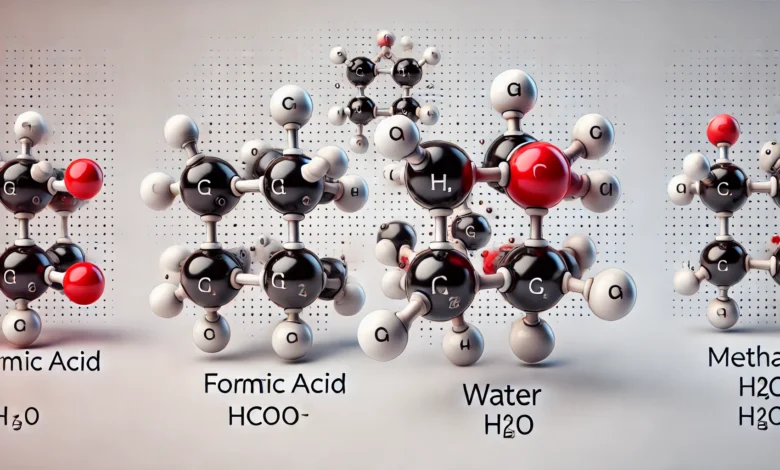Understanding HCOOH CH2 H2O: A Deep Dive into Its Structure, Properties, and Uses

HCOOH CH2 H2O When it comes to chemistry, certain formulas often look complicated at first glance, but once you break them down, they begin to make sense. One such formula that sparks curiosity is At first, it may look like a cluster of letters and numbers randomly arranged, but this formula actually connects to some very interesting aspects of organic and inorganic chemistry. In this article, we’ll break it down, explore its significance, understand the chemistry behind it, and even see how it ties into practical applications. Whether you’re a student, researcher, or just someone with a keen interest in science, this article will give you a complete understanding.
Breaking Down the Formula: What Does HCOOH CH2 H2O Mean?

When we first encounter HCOOH CH2 H2O, it might feel overwhelming. But chemistry is all about decoding. The formula is essentially a combination of formic acid (HCOOH), a methylene group (CH2), and water HCOOH CH2 H2O Each of these components has its own role and importance in chemical reactions.
Formic acid HCOOH CH2 H2O is the simplest carboxylic acid, commonly found in ant venom and some plants. It has fascinating applications in industries ranging from leather production to preservation. The CH2 group represents methylene, which plays a central role in organic chemistry by acting as a building block for countless compounds. Finally, H2O is water—probably the most studied molecule in the world, essential not just in chemistry but in all life processes.
When these components are written together, the formula hints at possible chemical relationships, reactions, or structures where these groups are involved. Chemists often write formulas like this to represent combined systems, reaction intermediates, or molecular associations. So, instead of seeing it as just “a messy formula,” it’s better to view it as a shorthand for something bigger and more meaningful.
The Role of Formic Acid HCOOH CH2 H2O in Chemistry
Formic acid is the star of this formula. As the simplest carboxylic acid, it sets the foundation for understanding more complex organic acids. Chemically, it’s made of a formyl group bonded to a hydroxyl group, and this structure makes it highly reactive compared to longer-chain acids.
One of the most remarkable features of formic acid is its natural occurrence. Ants, bees, and even stinging nettles produce it as a defense mechanism. If you’ve ever been bitten by an ant and felt that sharp sting, formic acid was at work. Beyond nature, it has significant industrial applications. It’s used as a preservative in livestock feed, a coagulant in rubber production, and even as a cleaning agent in laboratories.
In the context of HCOOH CH2 H2O, formic acid likely interacts with the methylene group and water to form intermediate structures or participate in reactions. It’s worth noting that in many organic synthesis pathways, formic acid can act both as a reactant and a solvent, which gives it a versatile role.
The Methylene HCOOH CH2 H2O Group: Why It Matters
Next up, we have CH2, known as the methylene group. At first glance, this might look simple—just a carbon with two hydrogens. But don’t underestimate it. Methylene is one of the most versatile building blocks in organic chemistry. It forms the “backbone” of countless molecules, from fuels to plastics to biomolecules.
What makes methylene special is its ability to link other groups together. In many reactions, CH2 serves as a connector, bridging functional groups and creating stability in molecules. For example, in polymers, repeating CH2 units form long chains that give plastics their strength and flexibility.
When placed alongside HCOOH CH2 H2O group could represent an intermediate stage in reactions like hydration, condensation, or polymerization. In other words, it’s not just sitting there—it’s part of a dynamic process where molecules come together, break apart, or transform into something new.
The Importance of Water HCOOH CH2 H2O in the Equation
Water may seem too ordinary to talk about in such detail, but when we look at HCOOH CH2 H2O, its presence is crucial. Water is often described as the “universal solvent” because it participates in countless chemical reactions.
In the context of organic chemistry, water is more than just a solvent. It acts as a reactant, catalyst, and stabilizer. For instance, in hydrolysis reactions, water directly breaks down larger molecules into smaller ones. In hydration reactions, it adds across double bonds to form alcohols. And in many acid-base systems, water helps balance equilibrium by donating or accepting protons.
By appearing in this formula, water likely suggests a hydrated form of formic acid or a reaction mixture involving methylene groups. This highlights how critical water is—not just in life processes but also in lab-based and industrial chemistry.
Possible Interpretations of HCOOH CH2 H2O
Now that we’ve explored the components separately, let’s bring them together. When written as HCOOH CH2 H2O, the formula might represent several possibilities depending on the context:
- A reaction system – It could describe the reactants or intermediates in an organic synthesis pathway involving formic acid, methylene, and water.
- A hydrated complex – In many cases, acids like HCOOH CH2 H2O exist in hydrated forms when mixed with water, sometimes interacting with carbon-based groups like CH2.
- A shorthand notation – Chemists often use condensed formulas to quickly represent systems without writing out full structural formulas.
Regardless of the exact meaning, the presence of these three components in one formula points toward active, reactive, and interconnected chemistry.
Industrial Relevance of HCOOH CH2 H2O
From an industrial perspective, each piece of this formula has enormous significance. Formic acid is used in agriculture, textiles, leather processing, and even renewable energy as a hydrogen storage medium. The CH2 group underlies much of polymer chemistry, which is at the heart of plastics, synthetic fibers, and resins. Meanwhile, water is indispensable in almost every industrial process, from cooling systems to chemical reactors.
When considered together, the combination of HCOOH CH2 H2O could represent an industrial process where acid treatment, organic bonding, and hydration all play roles. For instance, in resin manufacturing or organic synthesis labs, such a mixture may be part of a reaction pathway used to create valuable products.
Theoretical and Academic Importance
Beyond industry, the formula HCOOH CH2 H2O holds strong academic value. In teaching, it represents a perfect example of how formulas are not always straightforward—they may be condensed notations requiring interpretation. Students learning organic chemistry often encounter such notations, and breaking them down builds critical thinking skills.
Researchers, too, find relevance in such formulas. For example, studies in reaction mechanisms often involve hydrated acids, methylene intermediates, and the role of solvents like water. So, even a simple-looking formula can become the foundation for advanced research papers and lab experiments.
Real-World Applications of the Chemistry Behind It
So how does all of this connect to real-world applications? Quite directly, actually.
- In Agriculture: Formic acid is already used in silage preservation. When combined with methylene-based compounds, it could open up more efficient preservation techniques.
- In Medicine: Organic acids and hydrated intermediates are studied for drug formulations, where water’s presence stabilizes compounds.
- In Green Chemistry: HCOOH CH2 H2O has been researched as a hydrogen storage system. When studied with HCOOH CH2 H2O interactions, it could lead to cleaner energy solutions.
In essence, the mixture of these components represents both scientific curiosity and practical utility.
Challenges in Understanding and Using HCOOH CH2 H2O
Of course, not everything about this formula is straightforward. One of the biggest challenges is ambiguity. Without a clear reaction pathway or structural formula, interpretations can vary. Some may see it as a hydrated acid system, while others might interpret it as a reaction mixture.
Another challenge lies in the reactivity of the components. Formic acid is corrosive, methylene intermediates are unstable, and water can both stabilize and destabilize depending on conditions. Handling these substances in a lab or industry requires expertise and safety precautions.
Still, these challenges are part of what makes chemistry so fascinating. Ambiguity often drives research, and reactivity opens doors to new discoveries.
Final Thoughts: Why HCOOH CH2 H2O Deserves Attention
At the end of the day, HCOOH CH2 H2O is more than just a confusing formula. It represents the interconnectedness of simple yet powerful molecules: formic acid, methylene, and water. Together, they illustrate key principles of chemistry—reactivity, bonding, hydration, and application.
From classrooms to research labs, and from industrial plants to everyday life, the chemistry behind this formula matters. It teaches us not only about specific compounds but also about the broader way molecules interact, transform, and create value for humans.
So the next time you see a formula like HCOOH CH2 H2O, don’t just skim past it. Instead, pause, decode it, and think about the world of chemistry it represents.



